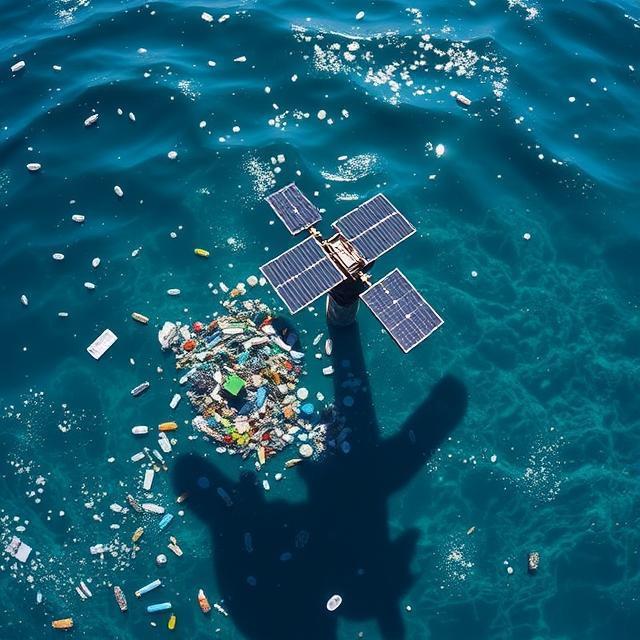Notifications

7 minutes, 51 seconds
-28 Views 0 Comments 0 Likes 0 Reviews

Our oceans are drowning in plastic. From floating debris to microplastics, pollution is threatening marine life and ecosystems. Traditional cleanup efforts, while noble, struggle to keep pace with the scale of the problem. That’s where artificial intelligence (AI) and satellite technology come in, bringing precision, speed, and real-time analysis to the fight against ocean pollution.
Mapping the Problem from Above
Tracking ocean plastic is incredibly challenging. The ocean is vast, constantly moving, and filled with all kinds of natural debris that can resemble plastic. However, modern satellites equipped with AI-powered imaging systems can scan wide ocean areas and distinguish plastic from natural elements like seaweed or foam. These systems analyze light reflections and thermal patterns to pinpoint patches of floating plastic, even in remote regions.
Organizations like The Ocean Cleanup and the European Space Agency are collaborating on tools that use machine learning models to filter through satellite images and detect pollution hotspots. AI processes this data to produce heatmaps showing the highest concentrations of plastic waste, which can then inform cleanup missions.
Real-Time Monitoring and Alerts
One of the most powerful benefits of AI in ocean cleanup is real-time tracking. Instead of relying on sporadic surveys or delayed reports, AI systems can analyze satellite data as it comes in. This enables:
Immediate alerts for new pollution events, such as illegal dumping or post-storm waste surges
Predictive models showing where debris is likely to accumulate based on current and wind patterns
Near-instant updates for on-ground and maritime cleanup crews
This agility ensures that interventions happen faster and more efficiently. For example, AI models can predict when a plastic patch floating in the Pacific will reach a coral reef or coastline, allowing local authorities to act before the damage is done.
Guiding Autonomous Cleanup Systems
AI’s role doesn’t stop at detection—it extends into the actual cleanup process. Robotic vessels and autonomous drones, equipped with cameras and sensors, use AI algorithms to navigate toward plastic hotspots and collect debris. These machines can operate 24/7 and in rough conditions where human crews might struggle.
Some of these AI-guided systems include:
Aquatic drones that skim the ocean surface
Robotic arms and conveyor systems that pick and sort debris
Solar-powered barges that autonomously steer into affected zones
These technologies reduce the need for manpower and make ocean cleanup scalable and sustainable over long periods.
Understanding the Source: Tackling Pollution at Its Roots
While collecting plastic is important, understanding where it comes from is crucial to stopping it at the source. AI helps here as well. By analyzing data from rivers, ports, shipping lanes, and industrial zones, AI can:
Identify high-output regions responsible for most plastic leakage
Correlate weather events and seasonal patterns with pollution surges
Model how land-based activity, like agriculture or urban waste, contributes to marine litter
Governments and NGOs can use these insights to implement more effective regulations, develop awareness campaigns, and hold polluters accountable.
Case Study: RiverWatch AI
An example of this in action is RiverWatch AI, a project combining satellite imagery and machine learning to monitor plastic flow from major rivers. The software identifies plastic outflows by analyzing color variations and patterns in river estuaries, allowing policymakers to prioritize cleanup or waste management efforts upstream.
Policy, Collaboration, and Global Action
AI is a tool, not a standalone solution. Its effectiveness depends on how it’s integrated into broader cleanup and prevention strategies. To maximize impact, international collaboration is essential:
Satellite data must be shared across borders
Cleanup efforts must coordinate with shipping companies and coastal nations
Policies must evolve to support AI deployment and ensure ethical data use
This means harmonizing environmental laws, investing in technology access for developing countries, and standardizing data collection methods so that AI can perform optimally across different regions.
The Role of Citizens and Tech Companies
AI-powered cleanup also benefits from citizen participation. Smartphone apps linked to satellite systems allow users to report sightings of plastic pollution, which AI can then cross-reference with satellite data to verify and map more accurately. This crowdsourced information improves the AI model’s accuracy while engaging communities in the conservation process.
Tech companies are also stepping up. Microsoft’s AI for Earth program and Google Earth Engine are supporting environmental groups with cloud-based AI tools, helping smaller nonprofits access powerful technologies without major upfront investment.
Challenges and Ethical Concerns
Despite the promise, some challenges persist:
Satellite imaging must comply with privacy laws and avoid unintended surveillance of human activity.
AI models require extensive training data, which isn’t always available or accurate in developing regions.
There's a risk of over-reliance on technology at the expense of community-driven solutions.
Transparency, inclusivity, and long-term vision are key to avoiding these pitfalls. Communities must be included in the design and deployment of AI tools to ensure that they address local realities.
The Road Ahead
The combination of AI and satellites marks a turning point in ocean conservation. By making pollution visible, trackable, and actionable, these technologies offer a much-needed boost to global cleanup efforts. However, they should be seen as part of a larger ecosystem of solutions that includes policy reform, education, sustainable product design, and international cooperation.
Conclusion
AI-powered ocean cleanup is no longer a futuristic idea—it’s already making a tangible impact. From tracking floating debris with satellites to guiding autonomous cleanup vessels, AI is transforming how we protect our oceans. But to fully realize its potential, we must combine it with human action, ethical oversight, and a shared commitment to ending plastic pollution. With the right mix of innovation and intention, we can truly turn the tide.

